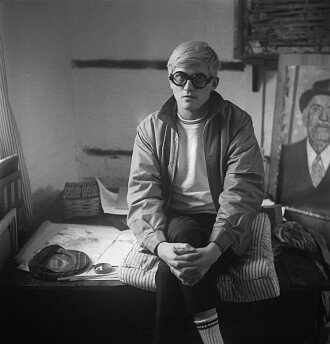“Someone said that the V.N. Paintings are abstract narratives. Certainly a great deal of thought and feeling have gone into them. For example, here at the beach I am between two great forces, the mountains and the sea. The mountains were made by a great force of nature . . . while below the other thrust continues, the endless movement of the sea. These forces are present, I believe, in the paintings. They are also quite sexual . . . These things were on my mind when I was painting them. Perhaps these paintings seem a jumble to the viewer at first. They take time to unfold. They’re a bit mind-boggling, but they are meant to be. The viewer can roam freely within them, finding his or her own space. That’s why there are no figures in them. You construct your own space mentally.”
T he Fifth V.N. Painting is an otherworldly early example of David Hockney’s explosively abstract V.N. Paintings of 1992. Together with the other twenty-five works in the series, the present work has been exhibited in New York City, Glasgow, Saltaire, Yorkshire and Venice, California. Iterations have been included in all of the artist’s most important museum retrospectives to date, including those at the Tate and Pompidou in 2017. A number are still held in the artist’s personal collection, a testament to the significance of the series within his body of work. The V.N. Paintings – short for ‘Very New’ – are unlike anything Hockney had previously created. The artist drew upon both his recent landscape paintings of the Santa Monica Mountain and his theatre set designs to explore representation, abstraction, and light. In 1990 and 1991 he worked on the production design for Puccini’s Turandot and Strauss’s Die Frau ohne Schatten, both of which opened in 1992. The opera sets were masterful studies of the effects projected light can have on a surface, fantastical landscapes shifting constantly under the bath of jewel-toned light. The present work evokes the spirit of a drive through Malibu, where Hockney lived at the time, but several times removed: imagine, perhaps, a scenic drive through Mars at dusk.

The Museum of Modern Art, New York
Right: ANDRÉ DERAIN, THE TURNING ROAD, L'ESTAQUE, 1906. MUSEUM OF FINE ARTS, HOUSTON
Textures, colors, shapes, and patterns abound in The Fifth V.N. Painting. The rich orange sky is decked with red dots and dashes like the seeds of a pomegranate. A reddish cave opens wide to swallow the teal ground and the writhing lavender form growing from it. Other forms attach themselves like intergalactic slugs; black checks, a grey curve, blue curls, and miniature Miro are all balanced within the composition like the pile of rock-like nubs emerging behind it. Light seems to come from both the front, behind, and above the scene all at once. Little white feathers fluttering down, a motif Hockney would revisit in The Sixth V.N. Painting. It is an altogether wild and dreamlike work.
By opening up his oeuvre to abstraction in the V.N. series, Hockney also opened up an entirely new field of influence. Indeed, through the swathes of saturated color, we can recognize the influence of a number of the great artists of the early Twentieth Century in the present work. We think of Pablo Picasso, who created works of comparable chromatic dynamism, with different passages of paint appearing to flow over one another; meanwhile, the specific juxtapositions of shape, tone, and hue, recall the work of Robert Delaunay, whose works hover between abstraction and figuration just like Hockney; or even Franz Marc, who executed colourist works that were just as dynamic, energetic, and engaging as this, using similar compositional devices. Impressionist and Post-Impressionist precedent has always been important to Hockney, and one would be tempted to chalk up the brusque horizontal dabs of brushwork that proliferate in this work as a reference to Claude Monet’s broad style.

Walker Art Center, Minneapolis
That last dimension, Hockney says, is time: “the time you give a picture when you look at it and it pulls you in and moves you round and you therefore become aware of taking time.” (The artist in That’s the way I see it, London, 1993, p. 234). The Fifth V.N. Painting reveals Hockney in a stage of pure, unadulterated abstraction, combining his skills in theatre set design with his own theories on perspective and metaphysics, as well as the eternal inspiration derived from the California landscape.
“The geometries that Hockney was exploring would go on to inform his paintings of the Grand Canyon later in the decade and his first paintings of Yorkshire. The narratives contained within each painting are what the viewer brings to it in terms of their movement into and through its depicted and suggested surfaces and spaces. With these paintings, Hockney believed that he was starting to find a way to represent three and four dimensions, space and movement – as well as emotion – on the flat surface of two dimensions”

